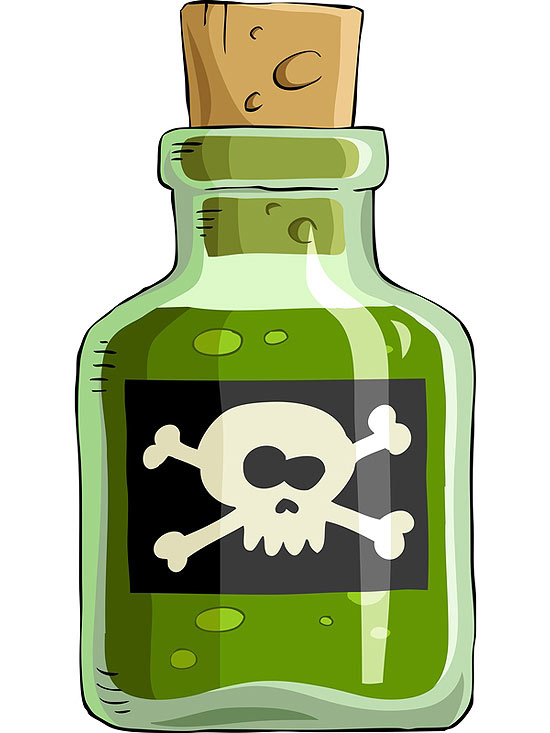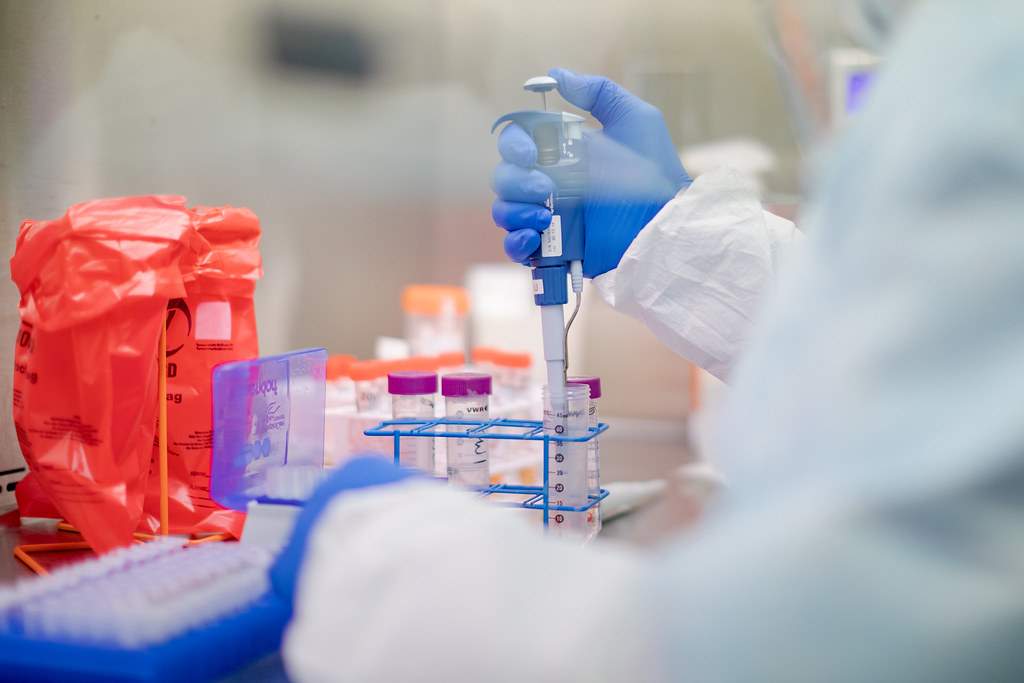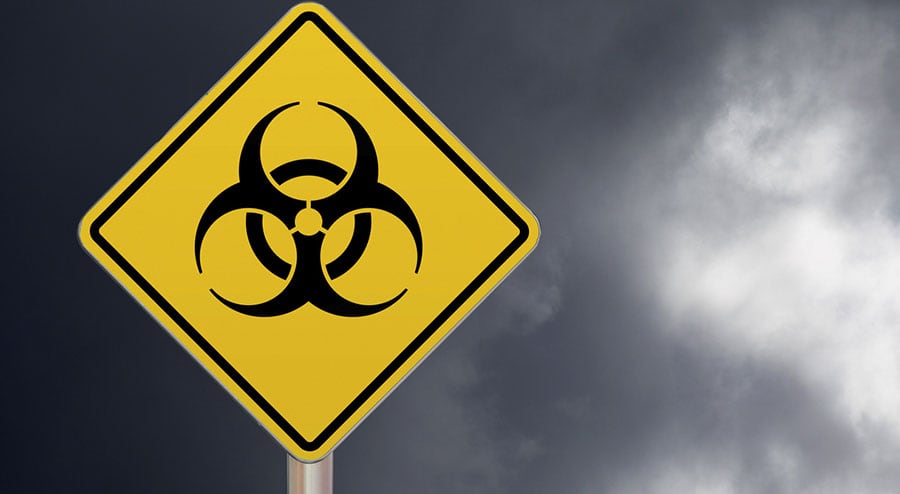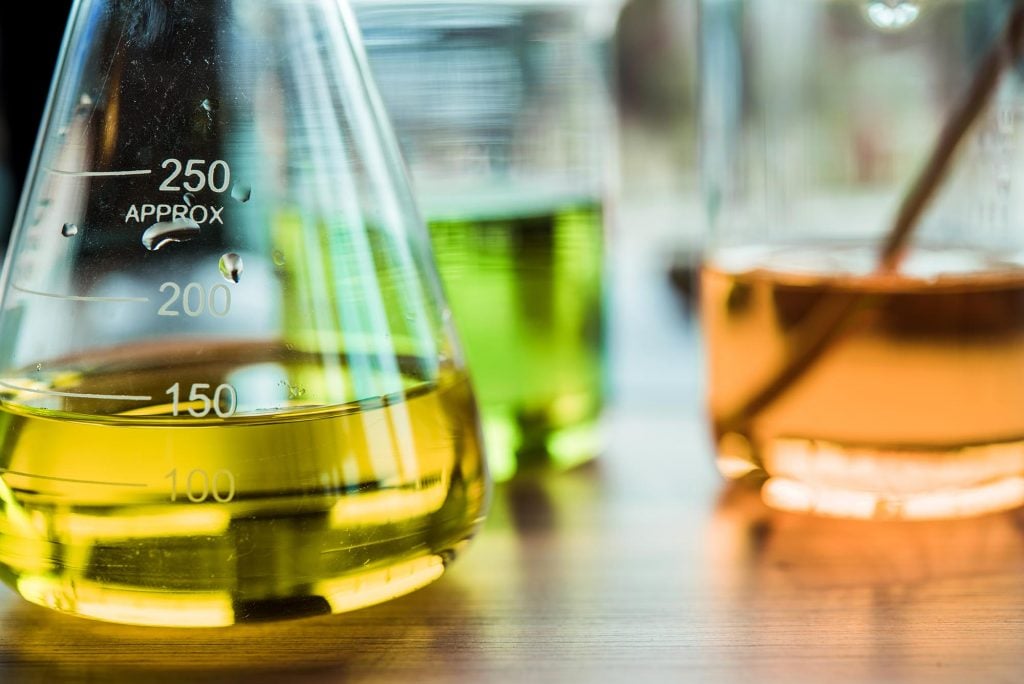You've heard that toxic chemicals are bad for you, but what exactly is a toxic chemical? The U.S. Environmental Protection Agency or EPA defines a toxic chemical as any substance which may be harmful to the environment or hazardous to your health if inhaled, ingested or absorbed through the skin. Many useful household projects contain toxic chemicals. Common examples include:
- Drain cleaner
- Laundry detergent
- Furniture polish
- Gasoline
- Pesticides
- Ammonia
- Toilet bowl cleaner
- Motor oil
- Rubbing alcohol
- Bleach
- Battery acid
While these chemicals may be useful and even necessary, it is important to remember they should be used and disposed of according to instructions on the packaging.
What is a chemical?
Everything in the physical world around us is made of chemicals. The earth we walk on, the air we breathe, the food we eat, the cars we drive, and the houses we live in are all made of various chemicals. Living organisms such as plants, animals, and humans are also made of chemicals.
Some of the chemicals we contact in our daily lives are man-made. These man-made chemicals include some drugs, cosmetics, workplace products, household cleaning agents, and so on. Many more chemicals which we are exposed to each day occur naturally and are found in our food, in the air, and in water. There are far more natural chemicals in our environment than man-made ones. Both man-made and natural chemicals can have poisonous effects.

What makes chemicals poisonous?
There are several factors which can influence the degree of poisoning caused by a chemical. These factors are as follows:
- Route of entry into the body
- Amount or dose entering the body
- Toxicity of the chemical
- Removal from the body
- Biological variation
What are the routes of entry into the body?
No chemical can cause poisonous effects without first coming into contact with the body.
Inhaling (breathing in) contaminated air is the most common way that workplace products enter the body. Some chemicals, when in contact with the skin, can seep through the skin. Less commonly, workplace chemicals may be swallowed, for example from contaminated food or cigarettes. The eyes may also be a route of entry. Usually, however, only very small quantities of chemicals in the workplace enter the body through the mouth or the eyes.
Why does the amount or dose entering the body matter?
The amount or dose of a chemical entering the body is probably the single most important factor which determines whether a chemical will cause poisoning. The amount of a chemical which causes poisoning depends on the chemical.
Consider, for example, what happens when water is drunk on a warm summer day. The water cools the body and quenches the thirst. Normally, water would be considered a harmless chemical. What if instead of just one glass, many glasses were consumed one after the other, non-stop. A point would be reached where beneficial effects would disappear and harmful effects would start to be noticed. Drinking too much water causes water intoxication. In severe cases, this kind of poisoning causes convulsions and seizures. There are reports of such poisoning occurring, for example in small children. The reason water changes from being harmless to being harmful is directly related to the amount of it taken into the body at one time. Drinking too much water causes the toxicity. Similarly, taking too much of a chemical into the body causes toxicity. This relation is true for all chemicals regardless of whether they are natural or man-made. What too much means depends on toxicity of the chemical.
What is the toxicity of the chemical?
Toxicity is a measure of the poisoning strength of a chemical. Chemicals with low toxicity require large doses or amounts to cause poisoning. Chemicals with high toxicity only need small doses to cause poisoning.
Toxicologists use animal tests and other methods to determine whether small or large doses of a particular chemical cause toxicity.
There is a tendency to think of chemicals in terms of those which are poisonous and those which are harmless. This terminology is used for convenience, but the words imply that toxicity or its absence is an all-or-nothing property of a chemical. All-or-nothing is not the case because any chemical can cause poisoning if a sufficient dose of it is taken into the body.
To put it another way, all chemicals have the potential to be poisonous. It is the amount or dose taken into the body that determines whether or not they will cause poisonous effects. Poisoning, then, is caused not just by exposure to a particular chemical, but by exposure to too much of it.
What is meant by the rate of removal from the body?
Some workplace chemicals which enter the body are excreted from the body unchanged. Others are broken down. The breakdown products may be more or less harmful than the original chemical. Other chemicals are stored temporarily in body organs and are removed over a short period of time. Eventually most chemicals and their breakdown products are removed as waste in the feces, urine, sweat or exhaled breath. A few chemicals such as graphite or silica dusts can be inhaled into the lungs where they lodge for many years and may never be completely removed.
As a general rule there is less risk of chemically caused harm if the body can do one or both of the following:
- break down the chemical into less harmful chemicals
- rapidly remove the chemical from the body.
What is biological variation?
Several characteristics of the exposed person can influence the degree of poisoning which occurs. These characteristics include age, sex and individual susceptibility.

How are we exposed to amounts of chemicals sufficient to cause poisoning?
There are two main ways that too much of a chemical can enter the body and cause poisonous effects:
By sudden or short term-exposures
A one-time exposure to relatively large amounts of the chemical can overwhelm the body. In the workplace, this exposure may happen through improper handling of the chemical, or when there is a spill or a leak from a valve or pipe carrying chemicals. It might also happen during maintenance or cleaning of equipment that normally contains chemicals (such as a solvent vat). The harmful effects caused by one-time, sudden, high exposures are often called acute toxicity effects. Some examples of acute toxicity are listed below:
- Inhalation of high concentrations of acid vapours might cause serious burns of the mouth and the airways leading to the lungs.
- Skin contact with certain organic solvents that are absorbed through the skin may cause dizziness and nausea.
- Inhalation of dusts can cause irritation of the respiratory tract, dryness in the throat, and coughing.
By repeated exposures over a long period of time
A repeated exposure over a long period of time can also cause too much chemical to enter the body and produce poisoning. This kind of poisoning occurs because the exposure is repeated day after day over many years. The exposure levels may be too small to cause acute toxicity. Harmful effects caused in repeated exposure situations are sometimes called chronic toxicity effects. The following are some examples of chronic toxicity:
- Inhalation of certain acid vapours at concentrations may, over long periods of time, cause loss of tooth enamel, eventually leading to extensive tooth decay.
- Inhalation and skin absorption of some organic solvents may, over long periods of time, cause damage to nerve tissue.
- Repeated exposure to dusts containing quartz can cause scar tissue in the lungs. This effect eventually leads to severe and permanent lung damage.
What else do we know about acute and chronic toxicity?
Most chemicals can cause both acute and chronic toxicity depending on the conditions of exposure. The adverse acute and chronic health effects caused by the chemical can be quite different. It is not usually possible to predict what the chronic toxicity of a chemical might be by looking at its acute toxicity, or vice versa.
Acute toxicity
In most cases, much more is known about the acute toxicity of a chemical than its chronic toxicity. The understanding of acute toxicity comes from studies with animals exposed to relatively high doses of the chemical, from tests that use animal, human or other cells, or from comparison of the effects of very similar chemicals. Accidental exposure, spills and emergencies add to our knowledge of acute toxicity in humans. The health effects may be temporary, such as skin irritation, dizziness or nausea, or they may be permanent: blindness, scars from acid burns, mental impairment and so on.
Acute toxicity is often seen within minutes or hours after a sudden, high exposure to a chemical. However, there are a few instances where a one-time high-level exposure causes delayed effects. For example, symptoms of exposures to certain pesticides may not appear for several days.
Chronic toxicity
Much of the knowledge we have about chronic toxicity comes from animal experiments. In addition, much has been learned from studying groups of people occupationally exposed to a chemical for many years. As a general rule, chronic toxicity appears many years after exposure first began. The health effects occur only because the exposure has taken place repeatedly over many years. Chronic toxicity is thought to occur in one of two main ways. These two ways can be explained by using sodium fluoride and n-hexane as examples.
- Sodium fluoride, at very low concentrations (such as in toothpaste or drinking water), causes no noticeable harmful health effects, even after years of exposure. At these low levels, the effects are considered beneficial for teeth. However, if much higher concentrations of sodium fluoride enter the body repeatedly, they deposit and build up in the bones. At first, the amount of fluoride in the bone may not cause any problems, but after years of repeated high exposure, symptoms of bone disease may appear.
- On the other hand, the chemical n-hexane is not deposited or accumulated in the body. It is broken down in the liver. One of the breakdown products can attack nerve cells in the fingers and toes. These kinds of cell are not replaced by the body easily. With continued exposure for many years, the damage to the nerve cells increases until a point is reached where symptoms appear in the fingers and toes.
Repeated exposure to some chemicals for long periods of time may cause cancer. Often people express concern about cancer developing after a one-time exposure to a cancer-causing agent. While there is no absolute proof that cancer will not occur from a one-time exposure, most of the evidence indicates that repeated exposure over a long period of time is necessary before cancer develops.

What are the differences between toxicity and hazard?
There is a tendency to believe that if only small amounts of a chemical are needed to cause poisoning, then the risks associated with exposure to the chemical are very high. This case is not necessarily so. A high toxicity chemical can have a low risk to health if it is used with proper precautions. On the other hand, it is possible that a chemical of low toxicity may present a high risk to health if it is used inappropriately or incorrectly. Toxicity is a measure of the poisoning strength and is an unchanging characteristic of a chemical. Risk is not the same. It is a variable feature. Risk is defined as the combination of the likelihood of the occurrence of a harm and the severity of that harm. Risk, in this discussion, is the likelihood that a chemical will cause poisoning, given its toxicity strength, and the amounts and manner in which it is used, stored and handled. The toxicity (hazard) of a chemical cannot be changed, but the risk it presents can be controlled and minimized.



